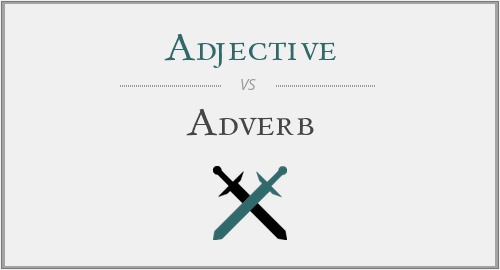We all learned about the different parts of speech in high school and most of us can easily distinguish between a noun and a verb. But when it comes to an adjective and an adverb, it is a little hard for us to recall what the real difference between them was. They both were somehow similar but still very different and we cannot remember what the difference between them was.
Today, I will explain to you in simple high school tongue the real difference between an adjective and an adverb and I will make sure that you won’t forget again ever in your life.
Adjective
An adjective is one of the eight parts of speech which define a noun. It describes the quality, identity and features of a noun or a pronoun and helps us get a better understanding of it. An adjective usually comes before a noun which can be one of a key character of remembering it but this is not true for every sentence. In some sentences, adjective might come after a noun.
Example:
The boy was sitting on a green bench.
In this simple sentence, the bench is a noun and ‘green’ is the adjective that is defining it.
Now consider this;
The bench he was sitting on was wet.
In this sentence, another quality of the bench (noun) is described by the adjective wet. The difference to note here is that ‘wet’ did not come before the noun but after it.
Another way of spotting an adjective in a sentence is to understand that an adjective mostly answers questions like how many? Or which? Or what kind?
Example:
The great magician showed four spectacular tricks.
In this example, the adjectives great, four and spectacular describe the nouns magician and tricks and also answers questions like what kind of magician? And how many tricks?
An adjective can also be recognized if you keep in mind its four types i.e.: Adjective of quality, Adjective of quantity, Adjective of number and Demonstrative adjective.
If we take into account the above examples, three of the four adjective types can be found in the sentence:
The bench he was sitting on was wet.

The great magician showed four spectacular tricks.
Here, wet is a demonstrative adjective, great is an adjective of quality whereas four is an adjective of number.
For adjective of quantity see this example;
She had some soup before bed.
Some describes the little quantity of soup she had so it is an adjective of quantity.
Adverb
An adverb is also among the eight parts of speech but it identifies and defines verb in a sentence rather than noun. An adverb describes everything for a verb which an adjective describes for a noun. It may come before or after a sentence.
Example:
The teacher was teaching poorly.
In this sentence, teaching is the verb and poorly is an adverb which is describing the quality of the verb. An adverb mostly carries an ly at their end as a suffix but it is not true for all adverbs.
An adverb answers questions like when, where, how and how much about a sentence. In the above sentence, poorly answers the question how the teacher is teaching.
Adverbs has many different types, the most important of which are adverb of time, place, frequency, manner and reason.
Consider the following sentences:
She came early to the party. (Adverb of time)
Get out of my house. (Adverb of place)
The girl apologized twice. (Adverb of frequency)
Thus he was forced to resign. (Adverb of reason)




Have a discussion about this article with the community:
Report Comment
We're doing our best to make sure our content is useful, accurate and safe.
If by any chance you spot an inappropriate comment while navigating through our website please use this form to let us know, and we'll take care of it shortly.
Attachment
You need to be logged in to favorite.
Log In